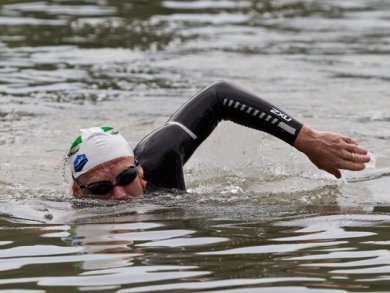Professor Andreas Fath, Furtwangen University (HFU), Germany, set out to swim through the Rhine starting from the source to the mouth in late July and, after approximately 1230 km, has now reached his destination, the Rhine delta in the Netherlands.
The aim of Fath’s aquatic journey was to emphasize on the importance of public water protection and to find sponsoring for a new analysis instrument. On his way, he was accompanied by a team of boats and collected water samples for further examination.
Antonia Niedobitek had the opportunity to ask Professor Fath a few questions for ChemViews Magazine.
Mr. Fath, how did you come up with the idea of swimming through the Rhine?
In 2011, I received a science award from the Fraunhofer Institute for Environmental, Safety and Energy Technology UMSICHT in Oberhausen, Germany, for developing an electrochemical method for the mineralization of perfluorinated tensides. I was working with the company Hansgrohe at the time, and they financed the pilot plant which was donated to the Furtwangen University together with the prize money from the UMSICHT award. However, up to then, we lacked the financial means for installing and operating the plant, and most importantly, for a process control via high performance liquid chromatography (HPLC-MS). We failed to acquire funding through research proposals and the faculty of Medical and Life Sciences of the HFU was not able to cover the costs either.
And then you took a more creative approach?
Exactly, I decided to combine two of my great passions: the chemistry of water and swimming. This way, I combined swimming through the Rhine with a useful purpose. The plan was to perform complete analysis focusing on current topics, such as microplastics, bacteria and viruses, using a new chip technology by Scienion, a sampler by EAWAG and rapid tests by Macherey-Nagel.
Now that you have completed your swim marathon, what would you say was the biggest challenge?
First of all, finding sponsors for the project; we needed 70 000 € to cover the costs of the swim project. Second, recruiting students for different tasks in the project, and arranging, packing and transporting the necessary instruments and equipment; and finally, of course, swimming 50 km a day and spending 6 to 10 hours in cold water was also a challenge.
Other than being cold, what else did you find out about the water you were swimming in? What are the results of your water analysis?
Rapid tests on oxygen, nitrate and phosphate concentration showed that the Rhine actually has drinking water quality. The risk of eutrophication is very low. The chemical oxygen demand (COD) value is slightly elevated, and further analyses are necessary to identify the organic compounds responsible for this. The first results will be presented at the 7th Hansgrohe Water Symposium in Schiltach/Schwarzwald in November.
Have you received positive feedback to your campaign yet?
Yes, there was a lot of positive response from the public and the media. I have also received a good offer for a HPLC-MS that we will purchase with the support of the board of executives.
Thank you very much for the interview. We wish you all the best and good luck with your project.
Andreas Fath earned his Ph.D. at the University of Heidelberg, Germany, in 1996. In the course of his career, he worked as a lecturer at the University of Heidelberg, as an editor of the journal Eurocosmetics and as a postdoc at Institute of Microstructure Technology (IMT) at the Karlsruhe Institute of Technology, Germany. From 2000 to 2011, he worked for Hansgrohe SE, Schiltach, Germany, in chemical developments and surface technologies. Since 2011, Fath is a Professor at the Furtwangen University (HFU).
Selected Publications
- A. Fath, J. McCarsky, Metallizing of plastics with virtually hexavalent chromiumfree etch solutions, Plating & Surface Finishing 2010, 46-52.
- A. Fath, Ökologische Bewertung verschiedener Technologien zur Reduktion der PFT Fracht in Industrieabwässern, Galvanotechnik 2010, 101 (8), 1886-1892.
- A. Fath, Elektrochemischer PFT Abbau in 33. Ulmer Gespräch, Innovationstreiber Galvanotechnik und Oberflächentechnik, Bd. 33, Leuze Verlag, Bad Saulgau, 2011, 59-67. ISBN: 978-3-87480-269-7
Also of interest
- Von der Quelle bis zum Meer: Schwimmender Professor erreicht Rheinmündung, Spiegel Online, 24.08.2014.
- Homepage of Andreas Fath
- Andreas Fath on the HFU website




